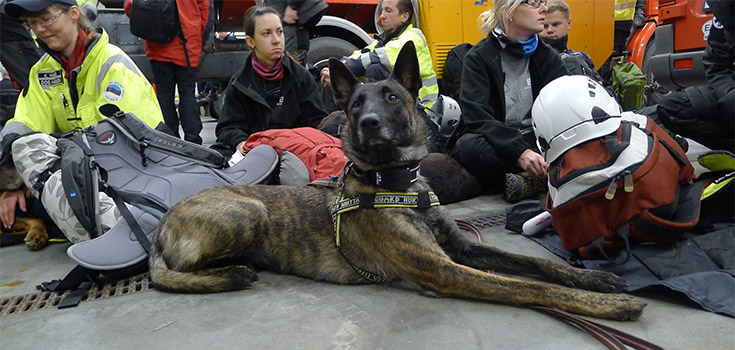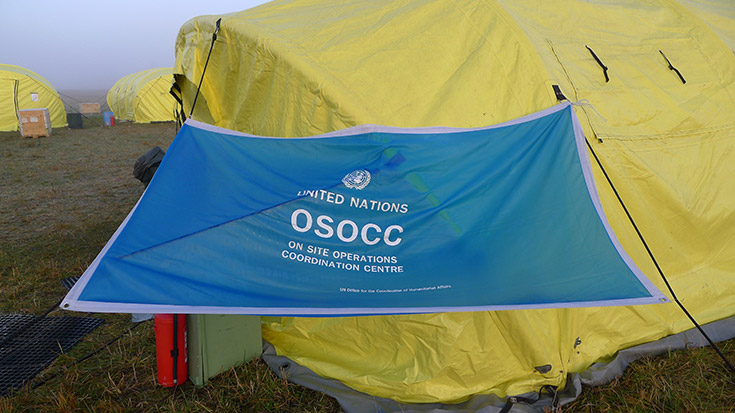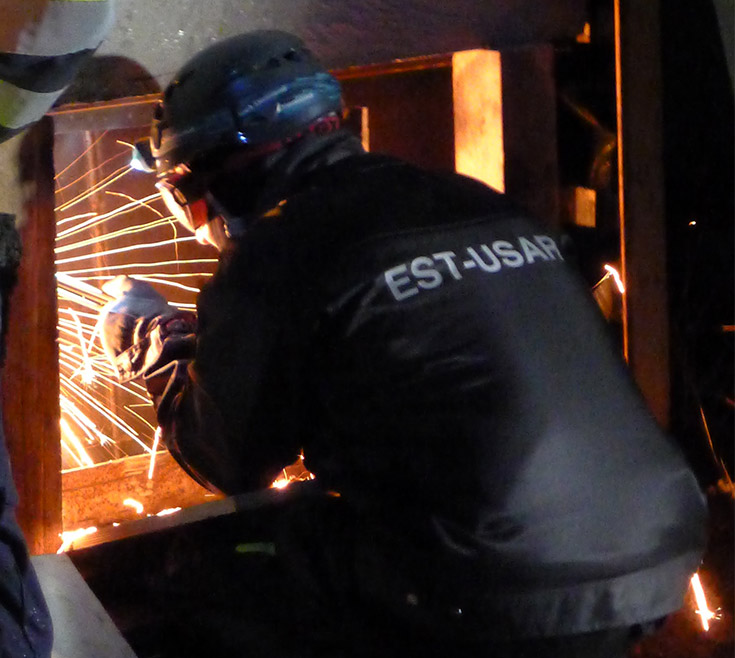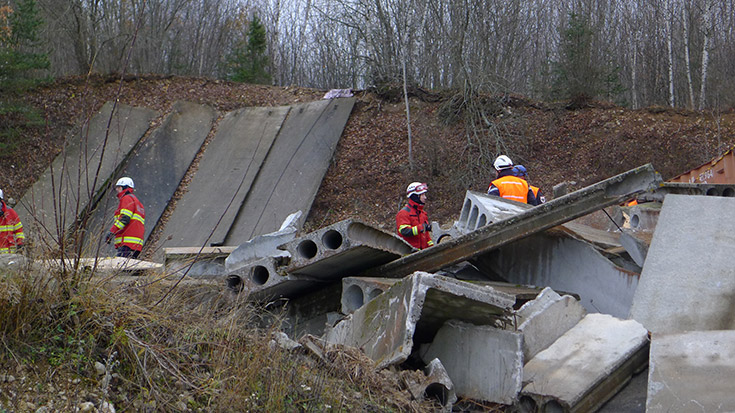Observing the EST-USAR IEC INSARAG Classifiers Programme in Estonia
This November, Editorial Advisory Panel Member Christo Motz was invited to act as an external observer on behalf of the CRJ for a 36-hour disaster exercise in Estonia

Classification is a peer review where best practices from the network are being shared
From Tuesday, November 3 to Friday, Nov 6, 2015, I acted as external observer on behalf of the Crisis Response Journal for a 36-hour disaster exercise, which was part of the five-day EST-USAR IEC Classifiers Programme. The Estonian USAR-team successfully executed the Simulation Exercise Plan during these days and has become part of the international INSARAG USAR community as medium team.
The International Search and Rescue Advisory Group (INSARAG), which was founded in 1991, is a global disaster response network of over 80 countries and organisations and has been part of the UN family since 2002. INSARAG focuses on Urban Search and Rescue (USAR), aiming to establish international minimum standardisation and classification for USAR teams as well as a methodology for international co-ordination in response to earthquakes and similar disasters. This system is based on INSARAG’s guidelines
On Monday, November 6, 2013, I met Terje Skavdal, former Chief of the Field Co-ordination Support Section (FCSS) and Secretary of INSARAG Emergency Services Branch, at the Kurhaus in Scheveningen. Skavdal invited me to attend an INSARAG Classification Programme in Turkey, but this was cancelled owing to a mining disaster in November 2014. From Istanbul I travelled to the WWI battlefield of Gallipoli. A year later Terje’s successor Jesper Holmer Lund put me in touch with Priit Laos of the Estonian Rescue Board (ERB), Head of the Northern Rescue Centre, who gave me permission to report on this training exercise.
I flew with LOT via Warsaw to Tallinn where I was met at 17:00hrs by Kiira, who also works at the ERB. As the evening sky darkened, we drove to the ERB Logistics Centre, a former Russian army base that contained a fire station and the EST-USAR Logistical mobilisation centre.
A team of INSARAG classifiers was commissioned, including members with various backgrounds originating from Denmark, Sweden, The Netherlands, France, Austria, the UK and Poland. Their role was to review and evaluate the preparations and implementation of the disaster exercise to see whether the EST-USAR team met the international INSARAG standards, methods and procedures.
Five disciplines were evaluated:
-
Management
-
Search
-
Rescue
-
Medical
-
Logistics
Per-Anders Berthlin, IntOps consultant from Sweden acted as a mentor; the eyes and ears of the INSARAG community. He also reported to the secretariat, firstly so as to optimally support the classification process and secondly owing to the political interests and to prevent a potential failure. Berthlin provided intensive coaching during the two years that it takes for the classification process, which includes preparation, compiling a portfolio, establishing benchmarks and advisory services.
It is essential that the response of a national USAR team meets an acceptable bare minimum standard. This includes basic humanitarian principles, a code of conduct, an open mind, respect for other solutions and approaches, legal status, safety, risks, effectiveness, care, kindness and helpfulness as important key elements.
There is also a commitment to sharing experiences and lessons, as well as good practice and that the teams are financed by their own national government. It is also crucial for teams to be able to operate under very complex national and international circumstances.
It is not only checklists and technical aspects of the admission procedure that are reviewed within the classification system. When all components have been documented in great detail, evaluated and discussed, the go-ahead is given and the last part of the classification exercise starts. This is based on checklists and standardised principles and goals. Once accredited and admitted to the international INSARAG community, there is a re-classification after five years, with even higher requirements and recommendations.

Speaking with Jacob Bolwinkel (Civil Protection), Head of the USAR-Department, Danish Emergency Management Agency (DEMA), he informed me that in the early days of international disaster relief before INSARAG was established, there was minimal co-ordination, but no uniform system. This changed when USAR started setting up Reception and Departure Centres (RDCs) for teams arriving in disaster areas in response to international aid requests. Their efforts were aimed at creating uniformity and clarifying expectations, operational efficiency and effort.
There are four main principles:
-
Establish contact and place regulations and command with the affected national government
-
Determine the scope of the actions
-
The affected country establishes the priorities
-
Contribution of the international community by deploying a temporary On Site Operations Co-ordination Centre (OSOCC) for incoming teams.
On October 31, 2015 at 14:05hrs local time, Virumaa, a fictional country in Northern Europe, experienced an earthquake with a force of 6.9 on the Richter scale. The epicentre was near Ebavere, about 30 km South of Rakvere. Several aftershocks followed, measuring 6.1 and 5. 8. The most affected area was the southwest of Virumaa. Many people were reported missing. It was expected that many buildings damaged in the first quake had collapsed and that there could be over 10,000 victims. According to the authorities, more than 40,000 people live in this region.
No other information was available and it was assumed that all critical infrastructure had failed. As Virumaa had insufficient resources and manpower to provide aid, there was an scaling up and a request for international support was issued.
The government of Virumaa addressed a plea to UN OCHA and EU ECHO for help. Upon receipt of the request, both organisations activated their aid delivery mechanisms. No other international aid organisations were yet active. Surrounding countries were making preparations and mobilising their USAR teams to help the distressed population of Virumaa. Circumstances could potentially deteriorate quickly as it was raining and temperatures were around freezing point. Hypothermia was a huge risk and the increase in landslides made access to the disaster area increasingly difficult.
Up and Downscaling
-
Phase 1 Preparatory request for aid, team members were notified
-
Phase 2 Preparing mission and departure from base
-
Phase 3 Arrival in stricken country and first activities
-
Phase 4 USAR operations
-
Phase 5 End of mission/demobilisation
The training exercise started on Tuesday November 3, 2015 at 18:00hrs when the Officer in Charge at Information Services of the Ministry of Internal Affairs of Virumaa reached out for help to the Estonian Rescue Board (ERB).
The request was activated by ERB using an established procedure, based on paragraph (§31 lg 2) of the Rescue Act.
Next, the ERB used its SMS system to mobilise its members:
-
M1 – Alert (potential mission)
-
M2 – Standby (members are selected for mission)
-
M3 – Mobilisation (members have three hours to arrive)
-
M0 – Stand down
Upon arrival at the mobilisation site, the EST-USAR crew trickled in, one by one. All needed to be present no later than 24:00hrs.
Registration, provision of equipment and materials and medical check-ups – a time-intensive process – followed the arrival of the team members.
Virumaa
The fictitious region of Väike-Maarja in Virumaa lay about 125 km from the Estonian capital Tallinn and 31 km from Rakvere. The EST-USAR team members needed to clear through customs first.
A few problems surfaced during the mobilisation process:
-
One team member was involved in a traffic accident
-
Two team members did not bring the right documents
-
One team member had health problems
-
One team member’s vaccinations were not up to date
-
Lack of internet access at the home base.
I noted that, especially in the first phase, it was a matter of waiting as it took hours before an actual course of action was taken. This might seem like a long time, but it is essential for all procedures to be checked and for the security conditions on site to be thoroughly reviewed.
Meanwhile at the Väike-Maarja Fire Station all EST USAR members including the K-9 rescue dog team, assembled between 05:00-06:00hrs on November 4, 2015. The EST-USAR team leader met with the Estonian Consul and Local Emergency Management Authority (LEMA) in Virumaa. Equipment was selected.
Meanwhile the airlifted containers with materials were unloaded and prepared for further transport by road. In this phase it was important that a Base of Operations (BoO) with a Reception & Departure Centre (RDC) was established; along with an OSOCC, in the vicinity of the disaster area.
EST-USAR ensured the OSOCC became operational. The LEMA provided input to OSOCC and the resident United Nations Disaster Assessment and Co-ordination (UNDAC) Team took charge of the RDC. BoO responsibility encompassed implementation of all operations in the various locations.
Rescue CollegeVäike-Maarja
In the meantime, I was stationed at the Fire fighting Training Institute in Väike-Maarja, a 20-minute drive from the training location. I had a private room with shared facilities and three square meals a day. A large group of young firefighters joined me in the mess hall, where the peace and quiet was remarkable.
Together with Dalius, a Latvian, and three Russian rescue workers we visited the disaster area under supervision of Kiira, who took us to the various locations at any time of the day/night. Her dedication and commitment are traits I find to be part of the Estonian can-do mentality. They want to move forward, there is a world to be gained.
Base of Operations (BoO)
The most important goal of the camp was to provide housing, a place to rest, and a hot meal for the first responders. Hygiene was important, which is why the camp was divided into two sections: a clean and a dirty zone. The tents were set up in an instant: no aluminium frames as everything was inflated using compressors and tethered with lines, sturdy as a house. All tents were air-heated using diesel generators. There were sleeping tents, showers, bathrooms; one tent served as a mess hall where Individual Combat Rations – Meals Ready to Eat (MREs) were provided.
For example, ration number four has a weight of 1.598, 22 g and contains 3,657.82 Kcal, sufficient calories for 24 hours and contained cans of soup, meat, granola, coffee, sweets, tea, bread and spreads.
USAR is basically completely self-sufficient for a period of seven to ten days, assuming that deployment for a longer time will hardly be required as the chance of finding survivors among the rubble after that time period would be slight.
The Project Manager is at the top of this hierarchical organisation. In this exercise, the role was fulfilled Priit Laos. Below him was the Head of Distaff (Directing Staff) and his Deputy, who were in charge of the sections on: Communication; Logistics/Camp; Safety/Security; and Exercise locations/Excon (Exercise control/Play centre).
In this scenario there were four to five locations where relief aid took place. Each team received information from Distaff. Simultaneously, each team was expected to gather as much information as possible and relay this information back.
The various disaster scenarios combined all USAR topics such as: Assessment; K9 search; moving and lifting; searching with listening and watching devices; breaking; shoring; and medical. Realistic scenarios were developed whereby K-9 dogs were also deployed.
-
Site 1 – Focus on Shoring, comprised a partially collapsed elementary school with severe structural damage and people trapped in the basement and on the second floor.
-
Site 2 – Focus on Breaking: This was a partially collapsed shopping mall with severe structural damage with both personnel and shoppers buried in rubble. There was also the possibility of environmental hazards.
-
Site 3 – Focus on Searching: Consisted of an office building of which the upper floors had collapsed; there was rubble and garbage around the building and water flowing in.
-
Site 4 – Focus on Searching and Breaking: Involved apartments with multiple storeys, with people trapped inside and a risk of fuel contamination (a three-ton storage tank at street level).
The rescue work was carried out in shifts, ensuring all teams received sufficient rest, while ensuring round-the-clock aid, including at night, security permitting. This made sure all tasks could be achieved and that as ‘victims’ as possible could be rescued from the rubble. The classifiers observed the operation, monitored whether all procedures were followed and how improvisations were included.

Observations
As an observer, the USAR’s methodical approach was interesting to watch, especially the differences and similarities in the way they worked as compared to firefighting teams in complex situations, where the command structure finds itself under extreme pressure and lines of communication are prone to failure. It was also interesting in relation to the action taken by individuals and groups of civilians who tried to save themselves during large scale incidents.
Within the natural/man-made disaster context, USAR can make a substantial difference for people in stricken areas worldwide. This is particularly true for USAR’s ability to approach missions in a multi-disciplinary way, and the ability of units to work autonomously in specific locations. Often teams stay on longer to help establish local medical infrastructure and to provide assistance and advice to medical personnel in the stricken region. The moral-ethical side is invaluable to help populations in distress know they can count on other countries to come to their aid.
A day after the successful closure of the training I spoke with a proud and happy Priit Laos in his Rescue Board office in Tallinn.
Laos told me that there was an INSARAG-team leader meeting in Tallinn in 2005. In the meantime Estonia has become the 44th member of the INSARAG community. According to him there are three main goals:
National preparedness with regards to local disaster situations;
Part of INSARAG: international support and participation as equal partner within the INSARAG community; and
Reciprocal aid: bilateral agreements with neighbouring countries.
Laos’s challenge is to connect the dots. In 2009-2010 Estonia was neither financially nor operationally ready for this admission procedure, and there were more obstacles to overcome.
After the heavy earthquake in Nepal on April 25, 2015, a 15-strong team of the EST-USAR was deployed together with the Finnish team in a Finnish aircraft. EST-USAR does not have its own aircraft, and hence co-operates closely with its neighbour Finland. Once in Nepal the teams became stuck in an airport and no USAR-teams were admitted. It was still a real mission, including all the stress, the unexpected, and procedures, and was an excellent preparation. EST-USAR has already been deployed in a few small-scale floods in Estonia, and sent three experts to Latvia on November 21, 2013, where a building had collapsed and 54 people perished, including three firefighters.

Now emphasis lies on implementing and integrating the INSARAG methodology of working within national disaster preparations. Future activities will focus on operating in cold environments. The plans include are MODEX EX 2016, DK (Modular EX) + AMPS (Advanced Medical Post & Surgery) and MODEX 2017, with the goal to become part of the Classifiers programme.
Christo Motz, 29/12/2015